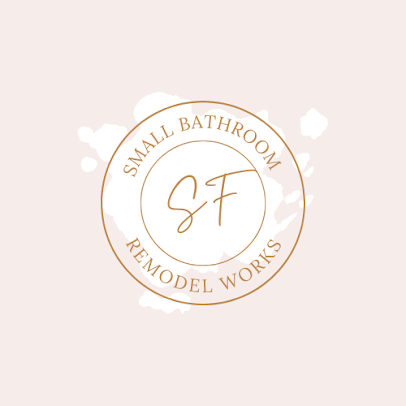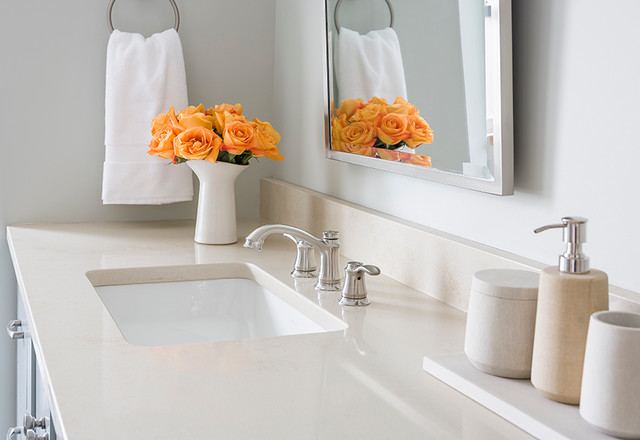This is an excerpt from the Book called “Ultimate Guide To Kitchens Plan-Remodel-Build“ . Continue reading to learn more about Bathrooms Countertops, thanks to the author.
Countertops
After your floor and wall choices, the countertop has the next biggest design impact in a bathroom. The larger the counter, the larger the impact, although small counters give you the opportunity to use more expensive materials and can be a focal point despite their diminutive site. Remember that countertops work in tandem with sinks and faucets-the right-sized holes may need to be drilled depending on the material you choose-so these decisions should be made at the same time.
Ceramic Tile
Countertops will take some abuse, so you need to select ceramic tiles that rated for this purpose. Floor tiles will certainly be strong enough, as will porcelain tiles. Some art tiles are too delicate for use on the countertop, and those with raised patterns can be hard to clean. Both are eye-catching options for the backsplash, however.
Ceramic tiles don’t need to be resealed and are impervious to water, heat, and stains, but the grout that holds the tiles together will require some maintenance. Apply grout sealer regularly; otherwise you may get some discoloration from mold or spills.
As with wall tiles you’ll want to pick a ceramic tile that has a complete line of accessories such as bullnose edges and trim pieces. You can also edge the countertop with wood or metal trim when there are no ceramic edging pieces in the design you choose.
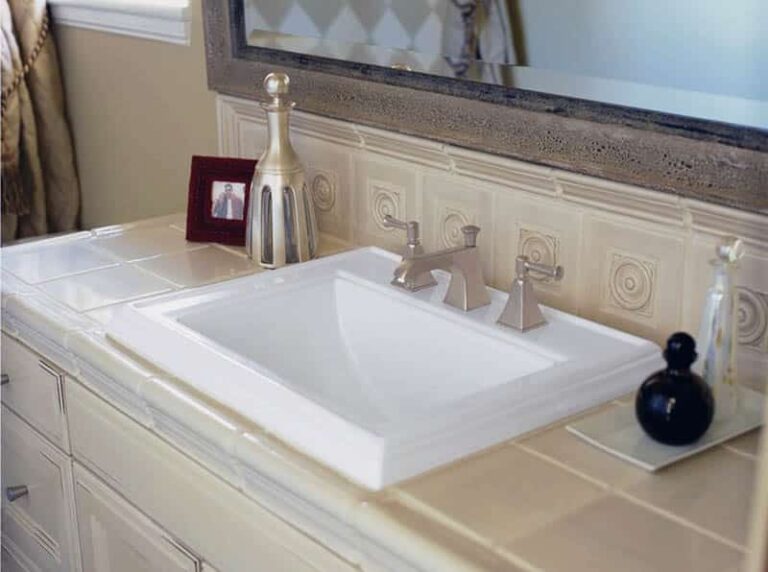
Glass
Glass tiles are available in squares and rectangles, and also as mosaics, in which small pieces in one shade or a rainbow of colors are mounted on a mesh sheet, creating a seamless look. Both options work for countertops, although mosaics have a lot more grout to maintain. You don’t have to worry about the slip factor with countertop tiles, so you can choose ones with a smooth finish, but you do need to select glass tiles that are strong enough for countertop use.
There are also solid glass countertops available in several finishes. Some manufacturers use recycled glass, but either way, the countertop itself is recyclable. You can leave the glass clear and see the floor and plumbing below, put a piece of steel or copper between the glass and vanity, or even install LED lights on the backsplash wall to illuminate the glass. These thick slabs are strong, easy to keep clean, and won’t be damaged by personal-care products, because glass is naturally nonporous. While they can be scratched, the slight texture of the glass will make the scratches less visible.
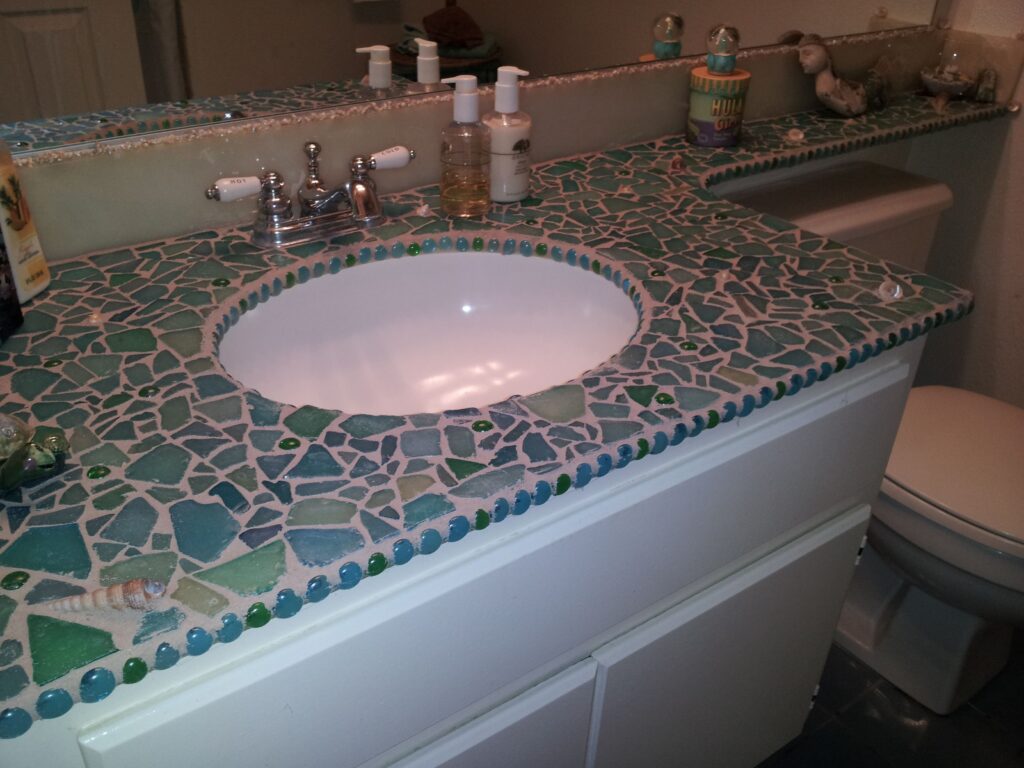
Stone
A natural stone slab countertop is one of the more expensive options, though you can get a similar look by installing stone tiles with extremely narrow grout joints in a color that matches the tiles. Another way to get a stone countertop without going over budget is to ask local stone yards and fabricators for scrap. “There are almost always pieces big enough for bathroom vanities left over from material used for kitchen countertops. Stone yards are often willing to sell the scrap for lower prices, and you’re utilizing something that may otherwise be discarded”, says interior designer Lou Ann Bauer.
Whether slab or tile, natural stone is porous and will need to be resealed regularly. While stone counters aren’t as difficult to product in the bathroom as they are in the kitchen, you will need to be careful not to spill any personal-care products that contain oil or alcohol. As with stone floors, it’s best to be realistic about yourself before committing to a stone countertop. If you’re not exactly a neat freak, you might be happier in the end with another type of counter. Of course, stone has been used as a countertop material for centuries by people who didn’t expect things to look flawless over the years. So if a little scratch or stain here and there won’t bother you, then you have nothing to worry about.
Fabricators can give stone slabs a variety of surface treatments; options include stone that has been polished, tumbled or honed. Interior designer Heidi Pribell likes to use acid-washed marble or limestone countertops in the bathrooms she designs. “In this process, the softer parts of the stone are worn away, creating a sense of patina. The surface undulates with an irregularity that feels warn and aged”, she says.
Visit a stone yard to view dozens of varieties, each with its own coloration and veining. When you work with a local fabricator and stone yard to create a custom countertop, you usually get to pick your own slab. Like slices of bread in a loaf, each slab will have a slightly different appearance, so the one you choose will be uniquely yours.
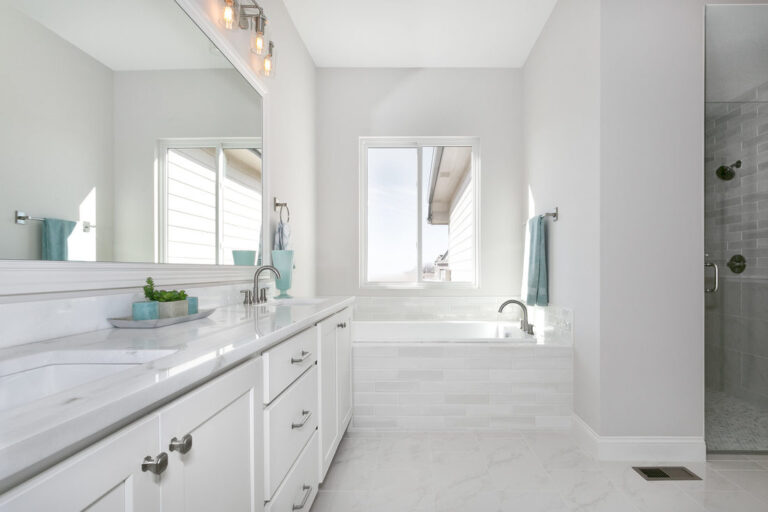
Fiber Cement
A few manufacturers are producing fiber-cement slabs in an effort to create a countertop that has the rustic elegance of solid concrete or stone but doesn’t weigh or cost as much. They are made of cement mixed with various fillers such as recycled glass and paper and need to be resealed regularly.
Solid Surface
Traditionally mad of plastic with a mineral filler, solid-surface countertops can be shaped and molded into any design. They are available in neutral or hot colors, as well as in patterns that resemble stone. Solid-surface countertops are durable, easy to maintain, and almost impossible to damage. Because the color and pattern extend all the way through the slab, scratches can be sanded out. You can now get solid-surface counters made with a small amount of recycled content.
There are also solid-surface countertops made of pressed paper that is sealed with resin and then baked. Some manufacturers use paper or wood pulp from sustainable forests and others use up to 100 percent postconsumer-waste recycled paper and petroleum-free resin, so there are a range of green options. While pressed paper may not sound durable, it’s harder than wood, heat resistant to 350 degrees, and stain resistant. As with plastic solid-surface countertops, scratches can be sanded away. Pressed-paper countertops are available in a variety of colors, slab sizes, and thicknesses, and they have a matte, slightly mottled finish that resembles soapstone.
Interior designer Terrell Goeke often uses solid-surface countertops when the cabinets are made of an exotic wood that has a lot of pattern to it so that he doesn’t have competing patterns. “Choosing solid surface is a great and practical way to use color, and you can also get bright colors in a matte finish, which is hard to find”, he says.
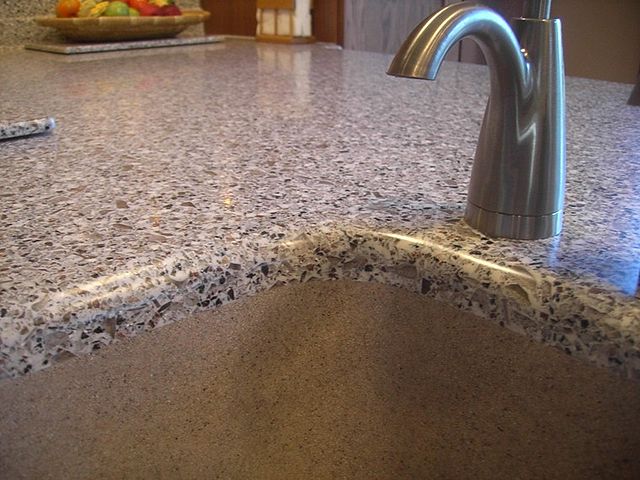
Laminate
Made of a thin layer of plastic bonded to particleboard or plywood, laminate counters are more affordable than many other countertop choices and are available in hundreds of patterns and colors. Look for brands that offer recycled or FSC-certified content. Unlike solid-surface countertops, laminate has visible seams. Flush and undermounted sinks should not be installed in a laminate countertop, because it’s too difficult to ensure that water won’t seep into the wood substrate. The best choice for a laminate surface is a self-rimming sink that overlaps the counter with a well-sealed caulk edge.
Stone and Glass Composite
For people who are concerned about the maintenance requirements of natural stone, there is another option that will give you a very similar look, at a similar price, but without the hassle. Stone composite, also referred to simply as quartz, is made of ground-up natural quartz mixed with polymers and epoxy. While natural stone slabs vary in color and veining, you can buy one quartz slab today and another a year from now and, depending on the mix of materials you choose, you probably won’t be able to tell the difference between them. The surface won’t be damaged by heat and is hard to scratch, you won’t have worry about spills. Little pieces of stone or glass suspended in each slab create an interesting visual texture, and the binding agents can be tinted anything from cream to bright red, giving you looks ranging from subdued to shocking.
CaesarStone offers a wide range of neutrals and a few hot colors in varying textures-from tiny specks to large chunks of quartz_ and there’s a line that contains recycled content. Architect Beth Gensemer is a big fan of CaesarStone countertops. “I Love the natural, light colors, plus a composite material like this requires a lot less maintenance than marble”, she explains. In addition to its standard quartz countertops, Silestone produces slabs that have the unique patterning of natural stone, a line with metallic aggregates, and a design called Volcano that has a lightly indented pattern across the surface, proving that the possibilities with quartz are almost limitless.
There are also a few small eco-friendly manufacturers such as Ice Stone that use 100 percent post-consumer recycled glass in a cement binder to create truly one-of-a-kind surfaces that are made in America. Unlike with quartz, there are no plastic binders in these countertops, so they will need to be resealed periodically.
Concrete
Sculptural and artistic, with the heavy permanence of a solid stone slab, concrete countertops can be tinted in earth-toned shades or bright colors and they generally have a mottled, matte finish, though gloss finishes are also possible. Concrete countertops can feature anything from hand prints of your kids to botanical patterns, or have an aggregate finish in which stone or glass is mixed in.
Unlike most other surfaces, concrete countertops may develop hairline cracks over time. Some people accept them as part of the look, but if cracks and visible wear and tear will bother you, then choose something else. Certain toiletries can stain concrete counters when spills are left to sit for hours, but resealing the counter regularly will help prevent stains.
Concrete countertops can be poured in place or purchased as pre-made slabs. Counters that are poured in place are often pure concrete and therefore very heavy. Some manufacturers offer lighter-weight concrete mixes that are more economical to ship and can be carried upstairs (by several strong people) for the installation. Sonoma Cast Stone offers a line called EarthCrete that is lighter in weight than traditional concrete, environmentally sustainable, and contains an additive that makes it stain-free without resealing.
Consider ordering an integral sink with you concrete countertop, meaning the counter and sink are formed as one piece with no seams. Concrete artists can create these sinks in unique shapes and depths to be features of your overall bathroom design.
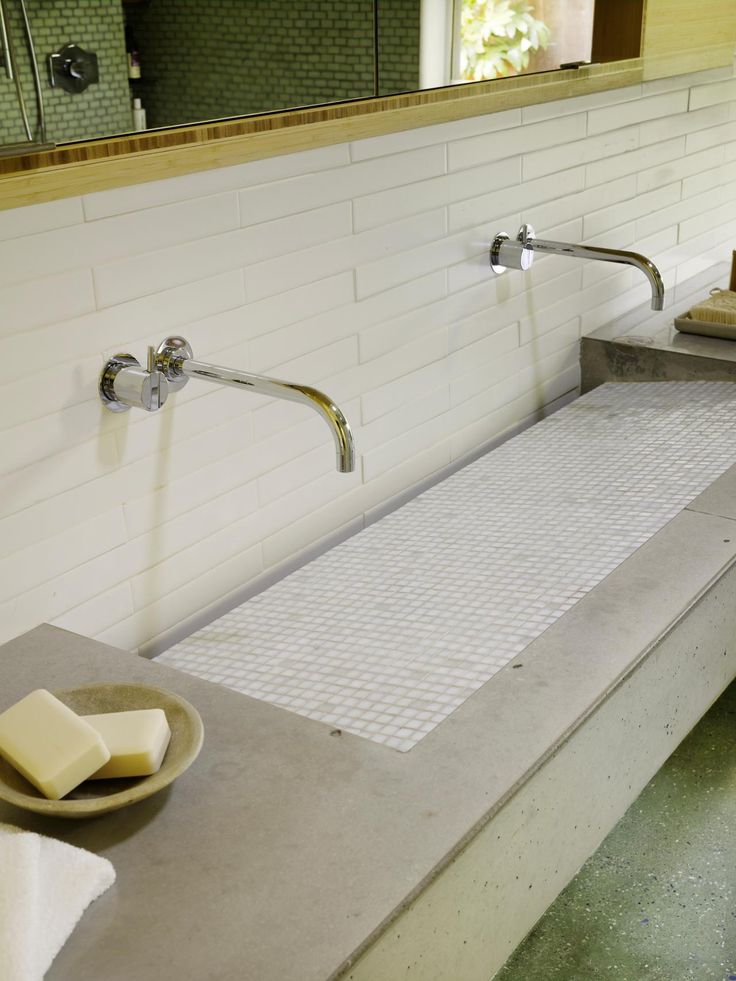
Metal
Stainless-steel counters are often seen in restaurant kitchens because they are easy to clean and sanitize and difficult to damage-all equally good qualities for a bathroom. As with concrete, you can order a stainless-steel countertop with an integral sink. Stainless steel is more affordable than concrete or composite countertops. It will get scratches, but those simply add to the aesthetic. Much more expensive and high maintenance are specialty metals such as copper and zinc, but their unique looks can be worth the money and frequent polishing if they work best with the style of bath you’re creating.
Wood
Warm and natural, wood countersxc are sometimes the best choice in rustic, cabin-style, or traditional bathrooms. To protect wood from splashes and spill, reseal it regularly. By working with a custom shop, you can get a wood countertop in practically any species and size. And if it ever gets stained or damaged, you can always have it refinished, just like a wood floor.
Backsplashes
To complete the look of your countertop, and protect the wall above it from splashes, you will need a backsplash. This is a great place to use a high-priced, big-impact material, as long as it won’t be difficult to keep clean. Any of the countertop materials described in the previous pages will work as a backsplash. For a harmonious design, you can choose something completely different.
The standard height for a backsplash is 4 inches, but it can be as minimal as you’d like or extend all the way to the ceiling. If you plan to incorporate a wall-mounted faucet, be sure you plan out the backsplash material carefully so you don’t end up with a grout line or seam right where the faucet needs to be.
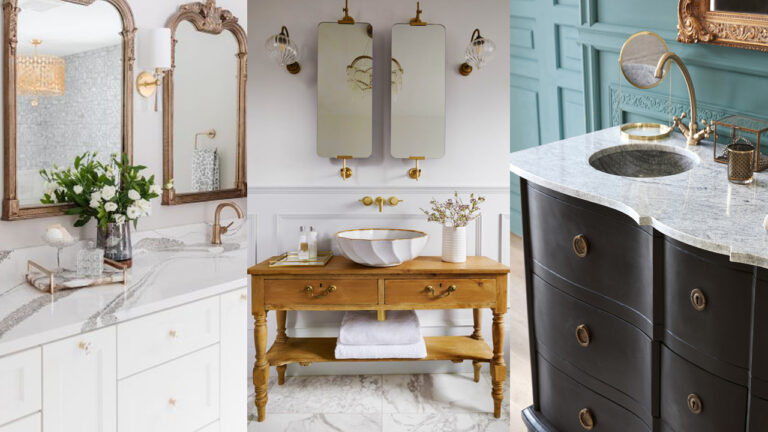
Countertops At A Glance
Ceramic Tile
- Pros: Broad range of sizes, shapes, and colors, water, heat, and stain resistant
- Cons: Limited to styles that are strong enough for countertop use; grout can be hard to keep clean and must be resealed regularly.
- Price: $-$$
- Installation: DIY friendly
- Green Issues: Look for tiles made of recycled material, or for salvaged or surplus tiles that would otherwise go to waste
Glass
- Pros: Stylish, unique, beautiful color palette
- Cons: Limited to styles that are strong enough for countertop use; grout can be hard to keep and must be resealed regularly (not an issue for solid-glass countertops)
- Price: $$-$$$
- Installation: If the tiles don’t have a solid sheet backing, use white mastic; otherwise you’ll see it through the tiles.
- Green Issues: Look for tiles made of recycled glass
Stone
- Pros: Luxurious; range of colors and patterns
- Cons: Some types are easy scratch; color and veining can vary from what you see in the showroom; heavy; some types need to be resealed regularly
- Price: $$-$$$
- Installation: Stone slabs require professional installation; stone tiles are a midlevel DIY project
- Green Issues: Choose a variety quarried close to home to reduce carbon emissions; select a leftover or salvaged slab that would otherwise go to waste
Fiber Cement
- Pros: Less expensive way to get the look of stone or concrete
- Cons: Must be resealed regularly to avoid stains; limited colors available
- Price: $
- Installation: Requires professional installation
- Green Issues: Select manufacturers that incorporate recycled materials into the concrete mix.
Solid Surface
- Pros: Available in hundreds of colors and patterns; can be made in any shape; can include integral sink(s); highly durable; scratches can be sanded out
- Cons: Plastic types are made from petrochemical-based materials
- Price: $$
- Installation: Requires professional installation
- Green Issues: Look for manufacturers that use postconsumer recycled paper and toxin free resin rather than plastics
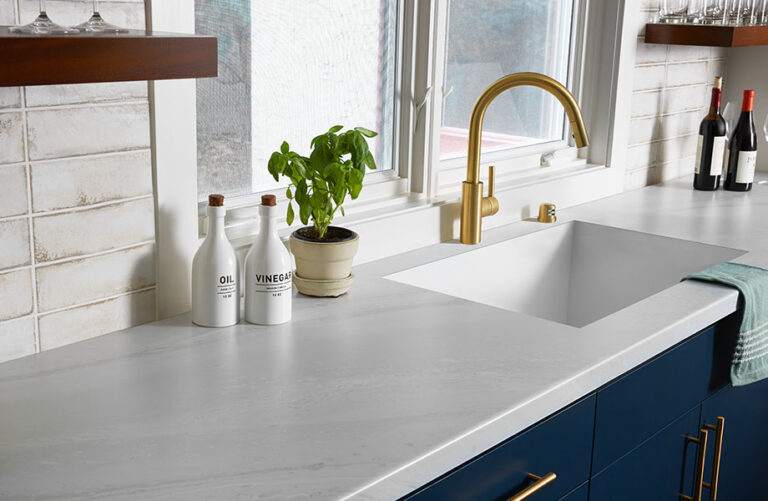
Laminate
- Pros: Available in hundreds of colors and patterns; can order as one piece with integral edge and backsplash
- Cons: Made from petrochemical-based materials; relatively easy to scratch; stains and scratches cannot be repaired; has visible seams
- Price: $
- Installation: Can be purchased ready-made of constructed onsite by experienced DIY’ers
- Green Issues: Look for manufacturers that offer Forest Stewardship Council (FSC) certification or recycled content
Stone and Glass Composites
- Pros: Nearly infinite range of colors and patterns depending on material used; heat, scratch, and stain resistant
- Price: $$-$$$
- Installation: Requires professional installation
- Green Issues: Look for manufacturers that use recycled content
Concrete
- Pros: Wide variety of aggregates, surface finishes, shapes, and colors; integral sinks available
- Cons: Can develop hairline cracks; heavy; most types must be resealed regularly to avoid stains
- Price: $$-$$$
- Installation: Hire an experienced contractor for best results
- Green Issues: Ask you contractor to substitute some of the Portland cement with recycled fly ash to reduce CO2 emissions by keeping the ash out of landfills
Metal
- Pros: Unique; stainless steel must be polished frequently; all show watermarks if water is allowed to sit on surface
- Price: $-$$$
- Installation: Requires professional installation
- Green Issues: Look for manufacturers that will create countertops out of salvaged metal
Wood
- Pros: Wide variety of species and stains; can be sanded and refinished
- Cons: Not heat or water resistant; must be resealed regularly
- Price: $-$$
- Installation: Professional installation is recommended
- Green Issues: Buy FSC- certified or reclaimed wood; use water-based, low-VOC (volatile organic compound) stains and finishes
